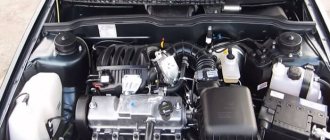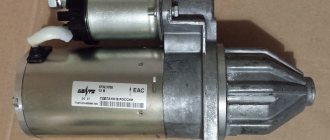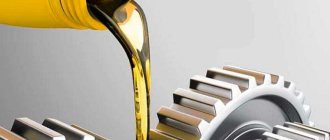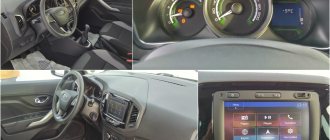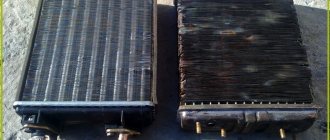Description
The VAZ-11183 engine was designed and put into production in 2004. Many design elements are taken from the VAZ-21114 engine. VAZ-11183 was produced until 2021. In 2011 it underwent a slight modernization, as a result of which it received an electronic drive for controlling the throttle valve (gas pedal).
The VAZ-11183 is a 1.6-liter gasoline inline four-cylinder engine with a power of 80 hp. s and torque 120 Nm.
Installed on Lada cars:
- 2112 (2004-2008);
- 2113 Samara (2004-2014);
- Grant (2011-2018);
- Kalina (2004-2013).
In addition to Lada, it can be seen under the hood of On-Do 1 (Datsun).
The opinion of auto experts about the engine is clear - the engine is simple in design and design compared to many other 8-valve AvtoVAZ engines.
The cylinder block is made of high-strength cast iron. The height is increased by 2.3 mm (compared to the VAZ-2110). Not sleeved.
The cylinder head is aluminum, with one camshaft and 8 valves (SOHC). To increase the compression ratio, the volume of the combustion chambers has been increased. There are no hydraulic compensators, so the thermal clearance of the valves has to be adjusted manually.
The crankshaft is steel, forged. It has a crank radius increased by 2.3 mm, which provides a piston stroke of 75.6 mm.
Timing belt drive. The main advantage is that the valves do not bend when they meet the pistons when the belt breaks. The engine simply stalls at this moment.
The attachments have their own drive belts.
Alternator belt drive
Power supply system – injector, distributed fuel injection. Practice has shown the possibility of using AI-92 gasoline. Justification - the compression ratio does not exceed 10 units (above 10 - only AI-95 or AI-98).
The advantage of the engine is the reserved safety margin, i.e. there is the possibility of tuning without reducing the mileage resource.
Advantages and disadvantages
The advantage of the 11183 engine is the cylinder head of the original design. However, it was subsequently further modified into the ICE 11186, adding volume to the combustion chambers. The downside is the generator belt tensioner - the drive is constantly over-tightened, a deflection of 10 mm is not ensured without slipping, so the belt life is reduced and it has to be changed more often. This defect was corrected only in the next version of the motor 11186.
The integrated catalytic collector assembly in the engine was initially unfinished:
Catcollector 11183
When installing the engine on the Lada Granta, the cabin heat exchanger was connected to the thermostat in series. All the coolant passed through it along a small circuit, the response temperature error was 5 degrees instead of the required 2 degrees.
Specifications
| Manufacturer | Concern "AvtoVAZ" | |
| Engine code | VAZ-11183 | VAZ-11183-50 |
| Start year of release | 2004 | 2011 |
| Volume, cm³ | 1596 | 1596 |
| Power, l. With | 80 | 82 |
| Torque, Nm | 120 | 132 |
| Compression ratio | 9.6 | 9.8 |
| Cylinder block | cast iron | cast iron |
| Number of cylinders | 4 | 4 |
| Fuel injection order | 1-3-4-2 | 1-3-4-2 |
| cylinder head | aluminum | aluminum |
| Cylinder diameter, mm | 82 | 82 |
| Piston stroke, mm | 75.6 | 75.6 |
| Number of valves per cylinder | 2 | 2 |
| Timing drive | belt | belt |
| Turbocharging | No | No |
| Hydraulic compensators | No | No |
| Valve timing regulator | No | No |
| Lubrication system capacity, l | 3.5 | 3.5 |
| Oil used | 5W-30 (40), 10W-40, 15W-40 | 5W-30 (40), 10W-40, 15W-40 |
| Fuel supply system | injector | injector |
| Fuel | gasoline AI-92 | gasoline AI-95 |
| Environmental standards | Euro 2-3 | Euro 4 |
| Resource, thousand km | 150 | 150 |
| Location | transverse | transverse |
| Weight, kg | 112 | 112 |
| Tuning (potential), l. With | 180* | 180* |
*tuning up to 120 hp is possible without loss of service life. With.
Overall figures between 21116 and 11186
Both the engine with the index 21116 and the engine 11186 have the same performance in relation to:
Both engines have the same problems:
Both Lada Granta with engine 11186 and Priora with engine 21116 consume fuel:
The engines do not have hydraulic compensators, so the valves need to be adjusted after 15,000 km. mileage _ And for ShPG it is necessary to exclude shock loads. Engines love only high-quality fuel, the reason is a high compression ratio and a tendency to detonation.
Engine VAZ-11183-50
This engine is a modification of the VAZ-11183. There are no fundamental design differences, but as a result of modifications:
- Power increased to 82 hp. With.
- Torque increased by 12 Nm.
- The environmental standard has increased to Euro
The main difference is that the unit is equipped with an electronic throttle control mechanism (type of action - “E-Gas”). The innovation improved engine controllability, but at the same time created a problem with the TPS sensor.
Engine builders managed to eliminate a number of shortcomings that were observed on its predecessor. For example, constant contamination of the throttle valve is a thing of the past.
Throttle Position Sensor (TPS)
As a result of modernization, the level of torque of the internal combustion engine and its elasticity have increased.
Car enthusiasts note that in general the engine has become more reliable and less capricious. At the same time, engine efficiency has decreased.
On which Grant engines do the valves bend when the timing belt breaks?
Current Grant owners claim that not all 8-valve engines are problematic. In particular, the “Standard” package is equipped with a truly high-quality power unit and will not cause serious damage to its future owner.
But “Norma” can make the driver worry, because a broken timing belt will lead to the need for long-term and expensive repairs. The differences between these engines, which are similar at first glance, lie in different equipment, so you need to pay careful attention to the type of unit when buying a car.
An engine marked 11183 (previously 2111) is quite noisy, but if the timing belt breaks, the valves will remain intact and undamaged. But many buyers would like to know whether the Lada Granta engine 11186 bends the valves, and how inevitable such a problem is.
Breakdowns will not occur if the car is inspected and diagnosed in a timely manner. But for unit 11186 (formerly 21114), even periodic checks will not always be a preventative measure.
Features of the 11186 engine are reduced operating noise, low fuel consumption and increased power. But in addition to the advantages, the modified power unit also received some problem areas: a new connecting rod and piston system. Its main difference is the lighter weight achieved as a result of shortening the pistons. As a result, the reduced space did not allow for practical and safe placement of the mechanisms.
Reliability, weaknesses, maintainability
Reliability
According to the conclusion of servicemen and car owners, the VAZ-11183 is more reliable in comparison with the concern’s previously produced engines. The increased quality of components and mechanisms used in the engine is especially noticeable.
The manufacturer has determined the average mileage resource. In reality, it is more than twice as much as stated. This fact is clearly confirmed by the increased reliability of the unit.
In addition, the engine is unpretentious during operation. The lubrication system especially benefits in this regard. The oil quality requirements are somewhat underestimated due to the lack of hydraulic compensators. The stable operation of the engine on low-octane gasoline also pleases most car owners. In other words, the efficiency of the internal combustion engine has been increased without sacrificing reliability.
The reliability of the timing system is beyond praise. A broken drive belt does not cause the valves to bend, which saves the car owner from expensive repairs.
On various forums you can find the following reviews: “... the engine is class, the traction is what you need, at low speeds 3 uphill, and even with a load of 4 people. 80 kg each. I only fill with 92, because... the engine is structurally very simple, it doesn’t need much to work well.” Another one - “... the 1.6 eight-valve engine is, by today’s standards, a stone age. But let's take a closer look at how it behaves on the road. When fully loaded, the power is quite enough, I drove the swallow 150 and there is still some reserve left.”
Thus, we can conclude that the VAZ-11183 is a completely reliable and economical engine.
Weak spots
Every engine has weak points. The unit in question did not escape them either.
Most often, car owners are alarmed by knocking noises in the engine. Moreover, both warm and cold. It is appropriate to note here that the engine itself is quite loud in operation (a design feature of the engine). But knocking can also be caused by unregulated valves. In any case, to find out the reasons for the loud operation, you need to contact a car service.
Engine overheating. The problem is typical for all VAZ engines. Usually solved by replacing the thermostat.
Electrics. It is also a weak link. Especially the different sensors. For example, DMRV. The result of its failure is engine failure (stalls while driving). Computer diagnostics of the internal combustion engine will help identify the resulting malfunction. Sometimes the ECU starts to malfunction. Also, you can’t do without computer diagnostics here.
Troubling of the internal combustion engine at idle speed can be caused by unadjusted valve clearances or burnt-out valves. The cause may be spark plugs. The true cause of the tripping can be easily identified at a specialized service station.
Oil leakage is a fairly common occurrence. The problem lies in poor-quality seals of mating parts and engine components. A simple tightening or replacement of the oil seal (gasket) allows you to forget about oil leaks for a long time.
In any case, the engine must be constantly monitored and any detected faults must be corrected in a timely manner.
Owner reviews
VAZ 2114 continued the tradition, and like its predecessor, it became a truly people's car. At one time it was the most affordable offer among non-mileage vehicles. This allowed it to become widespread and take its rightful place among other popular VAZ models.
Maksim. Lada 2114 1.6 l. 8th grade, 2010 180,000 km
I bought a car in 2015. The mileage on this example was quite decent, but the condition is good. I settled on the version with an 8-valve engine. Power is not so important for me, but they are considered much more reliable.
In general, this is confirmed so far. I only let you down once. When the temperature dropped below 30 degrees in winter, the battery died. But in fairness, it’s not entirely correct to make claims against the car itself.
Among the repair work, I did the replacement of the master brake cylinder and vacuum booster. We also had to change almost all the hoses under the hood. I recently had to replace the heater radiator. The rest is just consumables. I change the oil every 6-7 thousand, I only use synthetics. Many people do this on much higher mileages, but I like to play it safe. Moreover, given the quality of our fuels and lubricants, this will not be superfluous.
Among the shortcomings, we can note the quality of spare parts. Original spare parts from the factory do not serve flawlessly, but they have some margin of safety. Among the new ones there is a lot of different rubbish and defects. And this despite the fact that I try to buy the highest quality possible and not save. However, their “life” is very short. This is very frustrating and stressful. So I started thinking about selling.
Andrey. Lada 2114 1.6 l. 8th grade, 2008, 150,000 km
This car came to me unexpectedly. I was looking for a temporary second car for the family and settled on this option. I thought it wouldn’t be for long, but it turned out that I drove it for five years. All because I had to sell my main car. When purchased, the mileage was about 65 thousand.
There is not much to say about the ownership experience. A simple and unpretentious car. There are minimal amenities, but it doesn’t cause any trouble either. There is a minimum of electronics and electrics, and as a result it is quite reliable.
I didn’t have any breakdowns that would make it stand up straight on the road. I changed the clutch, replaced the timing belt and rollers three times (at my own request). Nothing more serious. I went for diagnostics a couple of times because the engine was not running very smoothly. Once we cleaned the throttle, and the second time we had to clean the injectors. I also replaced a rotten muffler.
Perhaps I would have kept it as a second car just in case, but it was starting to rot very actively. If not for this shortcoming, I would have given it a solid A. And so only four plus. For those who need a simple work machine for every day and are not too demanding, this is a very good option. The main thing is to find a specimen that is not killed or rotten through and through.
Nikolai. Lada 2114 1.5 l. 8th grade, 2006, 120 00 km
I purchased it in 2011 with 30,000 miles. The mileage is truly original, despite its age. I can say this for sure, since a friend had the car and was in plain sight all the time. I traveled for three years and did not know grief. I only changed consumables and all sorts of small things. But after the mileage exceeded 100 thousand, breakdowns began to appear.
First the stove stopped heating. Well, I thought it was a common thing: a thermostat or a faucet, but it’s not that simple. The antifreeze was slowly decreasing, but I thought it was coming from under the clamps somewhere, so I just added it little by little. Everything turned out to be much more serious. The temperature sensor was broken and was giving incorrect readings. That is, it showed normal temperature, but in fact it was overheating. It wasn’t actively boiling, but just a little bit at a time. Accordingly, the antifreeze gradually disappeared. As a result, such regular overheating gave me headaches. And minus the cylinder head gasket.
Then the ECU burned out. For some unknown reason. There is an opinion that the firmware is simply crooked. In the end I had to replace it. It cost, as they say, a pretty penny.
Well, little things somehow started to fall apart. And the quality of spare parts is absolutely poor. At least buy it in advance and rearrange everything around. Therefore, I sold it at 120 thousand. Perhaps I just came across an unsuccessful copy, because many people can easily ride for 200 thousand. But we need to clarify how much is being invested in repairs. I wasn’t happy with such fixed costs, so I decided to sell.
Judging by the mileage of 100 thousand, then everything is quite worthy, with the exception of corrosion resistance. Afterwards there is a big lottery. The car is suitable for those who love and know how to tinker themselves. The services turn out to be very expensive.
